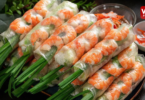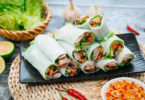Introduction
Banh Bao, a soft and fluffy steamed bun, represents the rich culinary heritage of Asia, especially in countries like Vietnam and China. With its pillowy dough and savory or sweet fillings, Banh Bao has won the hearts of food lovers worldwide. Whether enjoyed on the streets or in fine dining establishments, these versatile buns are a symbol of tradition and innovation in Asian cuisine.
History and Origin of Banh Bao

Banh Bao traces its roots back to ancient China, where it was known as “mantou” (馒头). According to legend, the famous general Zhuge Liang created the first version of these buns during the Three Kingdoms period. While leading his army across a dangerous river, Zhuge Liang was instructed to offer human heads as a sacrifice to calm the waters. To avoid such a gruesome act, he devised a solution: he shaped balls of dough resembling heads and threw them into the river. This marked the birth of what we now recognize as mantou, which later evolved into Banh Bao as it spread to other regions of Asia.
Over time, Banh Bao traveled to Vietnam and other neighboring countries, adapting to local tastes and ingredients. In Vietnam, Banh Bao typically features a rich filling of ground pork, quail eggs, and various seasonings, wrapped in a delicate, fluffy dough. The dish became a popular street food, appreciated for its convenience and heartiness.
Today, Banh Bao is enjoyed in many forms, from the traditional pork-filled version to modern twists featuring vegetarian fillings or even sweet, custard-like centers. Despite its variations, Banh Bao remains a beloved comfort food that continues to unite cultures and generations across Asia and beyond.
Popular Varieties of Banh Bao Throughout Vietnam
Banh Bao has evolved into various forms, each with its own unique flavors and fillings. Here are some of the most popular types available today in Vietnam:
- Pork and Quail Egg Banh Bao:
This is the most traditional version in Vietnam. It features a savory filling of ground pork, wood ear mushrooms, and a quail egg at the center. The balanced combination of textures and flavors makes it a favorite among locals.

- Char Siu Banh Bao (Banh Bao Xa Xiu):
A Cantonese-inspired version filled with sweet and savory barbecue pork (char siu). The rich, flavorful meat complements the soft, fluffy bun, making it a beloved option in dim sum restaurants.

- Vegetarian Banh Bao:
For those seeking a lighter option, vegetarian Banh bao is filled with a mix of mushrooms, tofu, and vegetables. It offers a healthy, plant-based twist on the classic bun while maintaining the same tender texture.

- Salted Egg Custard Banh Bao (Banh Bao Kim Sa):
A modern twist, Salted Egg Custard Banh Bao is filled with a rich, molten salted egg yolk filling that oozes out when bitten into. This version is often served as a dessert or a special treat, balancing the salty and sweet in a luxurious, creamy filling.

These varieties showcase the versatility of Banh Bao, allowing it to cater to different palates and dietary preferences. Whether savory or sweet, traditional or innovative, each type offers a unique taste experience while preserving the beloved soft, fluffy texture of the steamed bun.
Banh Bao – Vietnamese Steamed Pork Buns Recipe
Ingredients

– For the dough:
- 300g all-purpose flour
- 100g cornstarch
- 5g instant yeast
- 50g sugar
- 150ml warm milk
- 30ml vegetable oil
- 1/4 tsp salt
– For the filling:
- 200g ground pork
- 2 quail eggs (or regular eggs, halved)
- 50g shiitake mushrooms, diced
- 1 small onion, finely chopped
- 2 garlic cloves, minced
- 1 tsp oyster sauce
- 1 tsp soy sauce
- 1/2 tsp sugar
- 1/2 tsp ground pepper
- 1 tsp sesame oil
- 1/2 tsp cornstarch (for thickening)
Step-by-Step Instructions
1. Preparing the Dough
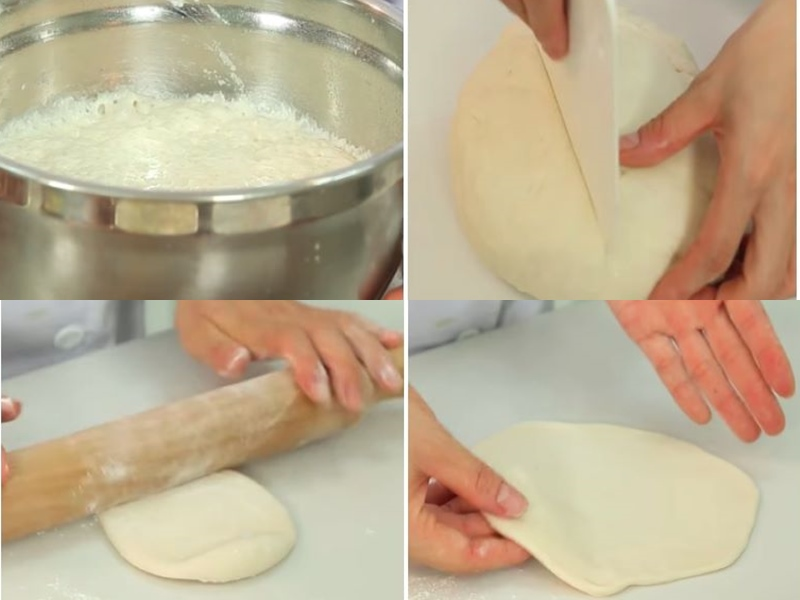
- In a small bowl, mix warm milk with sugar, then sprinkle yeast over it. Let it sit for 5-10 minutes until the yeast is activated and bubbly.
- In a large bowl, combine all-purpose flour, cornstarch, and salt. Make a well in the center.
- Add the yeast mixture and vegetable oil to the well. Gradually mix the wet ingredients with the dry ingredients until a dough forms.
- Knead the dough on a floured surface for about 10 minutes until it becomes smooth and elastic. If the dough is too sticky, add a bit more flour as needed.
- Place the dough in a lightly oiled bowl, cover with a damp cloth, and let it rise in a warm place for about 1-1.5 hours, or until it doubles in size.
2. Preparing the Filling
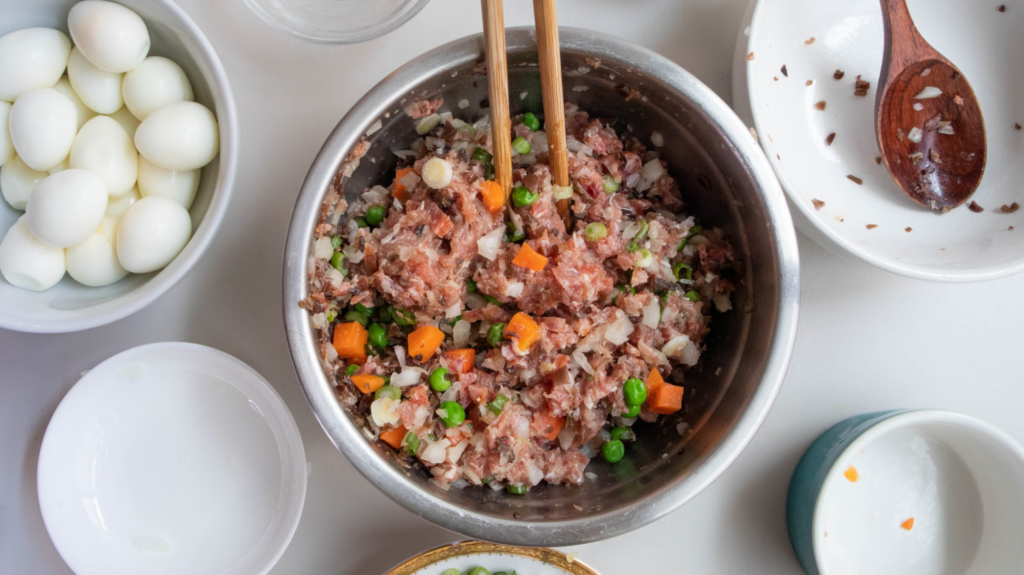
- Heat a bit of oil in a pan over medium heat. Add minced garlic and onions, sauté until fragrant. Then add the ground pork and stir-fry until it’s no longer pink.
- Add soy sauce, oyster sauce, sugar, pepper, and sesame oil to the pork. Stir in diced mushrooms and cook for another 3-4 minutes until everything is well combined.
- Dissolve cornstarch in a little water and stir it into the pork mixture to thicken. Remove the filling from the heat and let it cool.
- Boil the quail eggs, peel them, and set them aside. If you are using regular eggs, cut them into halves.
3. Assembling the Buns
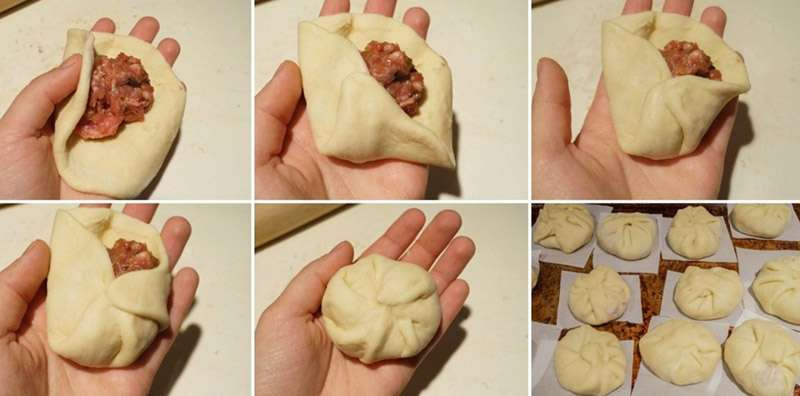
- Once the dough has risen, punch it down and divide it into equal portions (about 8-10 pieces, depending on the size you prefer).
- Roll each dough portion into a ball, then flatten it into a disk about 4-5 inches in diameter.
- Place a spoonful of the pork mixture in the center of each disk, adding a quail egg (or half of a regular egg) on top. Pinch the edges of the dough to seal the bun, ensuring the filling is enclosed tightly.
- Place the filled buns on parchment paper squares, cover them, and let them rest for another 10-15 minutes.
4. Steaming the Buns
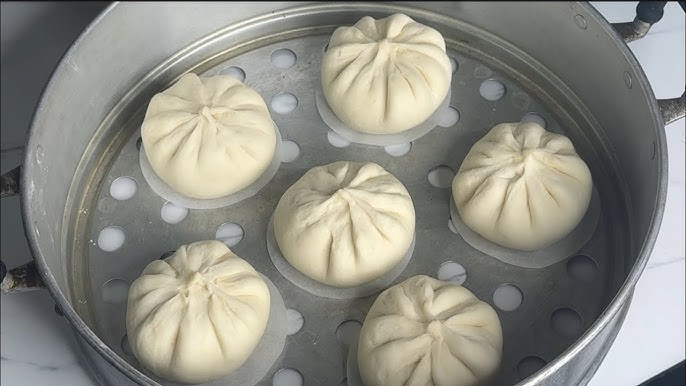
- Bring water to a boil in a steamer pot. Line the steamer trays with parchment paper to prevent sticking.
- Place the buns in the steamer, ensuring there’s space between each one as they will expand. Steam over medium heat for about 15-20 minutes until the buns are puffed up and fully cooked.
Tips:
- If you prefer a fluffier bun, you can substitute half the all-purpose flour with cake flour.
- Adjust the filling to your preference, adding other ingredients like carrots, peas, or glass noodles for a different flavor.
- For freezing, wrap each steamed bun in plastic wrap and store it in the freezer. Re-steam or microwave when ready to eat.
Conclusion
Today, Banh Bao’s versatility shines through, adapting to diverse tastes and dietary preferences—from the classic pork and quail egg filling to inventive sweet and vegetarian varieties. Its presence in street food markets, restaurants, and home kitchens reflects its enduring appeal and cultural significance.
As Banh Bao continues to delight palates worldwide, it remains a symbol of comfort and culinary tradition, bridging cultures and generations with every bite.
Experience the delight of Banh Bao today! Try making these delicious steamed buns at home and discover a new favorite in your culinary repertoire. Gather your ingredients, follow the simple steps, and enjoy the rich flavors and comforting texture of freshly made bánh bao. Don’t wait—start cooking and savor the taste of tradition!
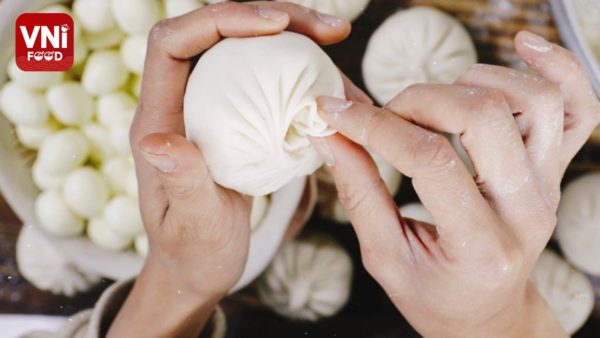
| Prep Time | 20 minutes |
| Cook Time | 45 minutes |
| Servings |
people
|
- 300 g All-purpose flour
- 100 g cornstarch
- 5 g instant yeast
- 50 g Sugar
- 150 ml warm milk
- 30 ml vegetable oil
- 1/4 tsp Salt
- 200 g Ground pork
- 2 quail eggs (or regular eggs, halved)
- 50 shiitake mushrooms, diced
- 1 small onion, finely chopped
- 2 garlic cloves, minced
- 1 tsp Oyster sauce
- 1 tsp Soy sauce
- 1/2 tsp Sugar
- 1/2 tsp Ground pepper
- 1 tsp Sesame oil
- 1/2 tsp cornstarch (for thickening)
Ingredients
For the dough
For the filling
|

|
- In a small bowl, mix warm milk with sugar, then sprinkle yeast over it. Let it sit for 5-10 minutes until the yeast is activated and bubbly. In a large bowl, combine all-purpose flour, cornstarch, and salt. Make a well in the center. Add the yeast mixture and vegetable oil to the well. Gradually mix the wet ingredients with the dry ingredients until a dough forms. Knead the dough on a floured surface for about 10 minutes until it becomes smooth and elastic. If the dough is too sticky, add a bit more flour as needed. Place the dough in a lightly oiled bowl, cover with a damp cloth, and let it rise in a warm place for about 1-1.5 hours, or until it doubles in size.
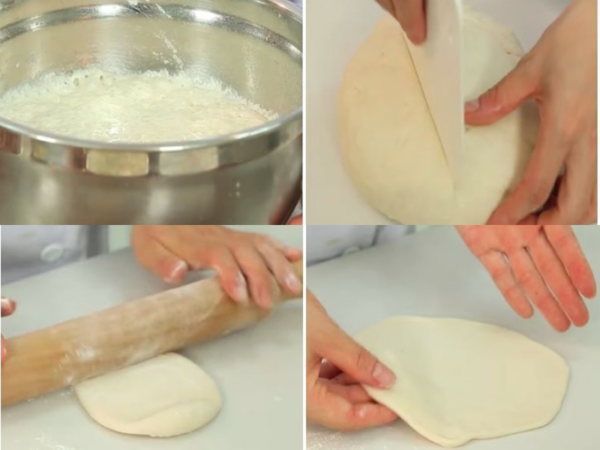
- Heat a bit of oil in a pan over medium heat. Add minced garlic and onions, sauté until fragrant. Then add the ground pork and stir-fry until it’s no longer pink. Add soy sauce, oyster sauce, sugar, pepper, and sesame oil to the pork. Stir in diced mushrooms and cook for another 3-4 minutes until everything is well combined. Dissolve cornstarch in a little water and stir it into the pork mixture to thicken. Remove the filling from the heat and let it cool. Boil the quail eggs, peel them, and set them aside. If you are using regular eggs, cut them into halves
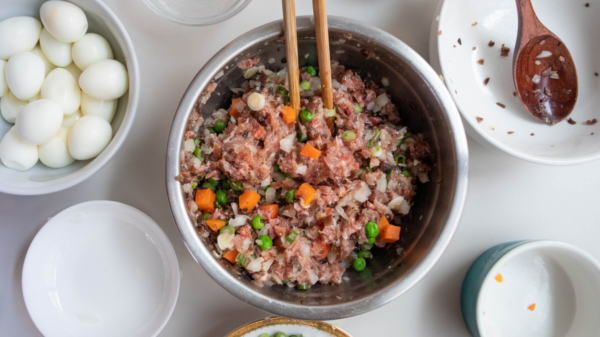
- Once the dough has risen, punch it down and divide it into equal portions (about 8-10 pieces, depending on the size you prefer). Roll each dough portion into a ball, then flatten it into a disk about 4-5 inches in diameter. Place a spoonful of the pork mixture in the center of each disk, adding a quail egg (or half of a regular egg) on top. Pinch the edges of the dough to seal the bun, ensuring the filling is enclosed tightly. Place the filled buns on parchment paper squares, cover them, and let them rest for another 10-15 minutes.
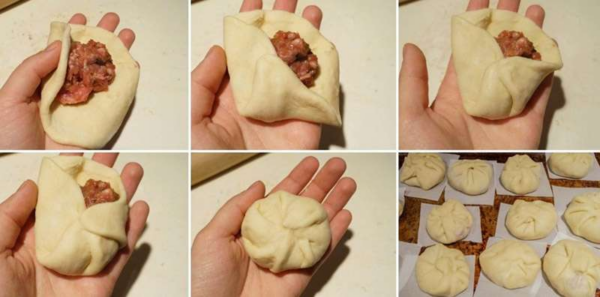
- Bring water to a boil in a steamer pot. Line the steamer trays with parchment paper to prevent sticking. Place the buns in the steamer, ensuring there’s space between each one as they will expand. Steam over medium heat for about 15-20 minutes until the buns are puffed up and fully cooked.

Tips:
- If you prefer a fluffier bun, you can substitute half the all-purpose flour with cake flour.
- Adjust the filling to your preference, adding other ingredients like carrots, peas, or glass noodles for a different flavor.
- For freezing, wrap each steamed bun in plastic wrap and store it in the freezer. Re-steam or microwave when ready to eat.


